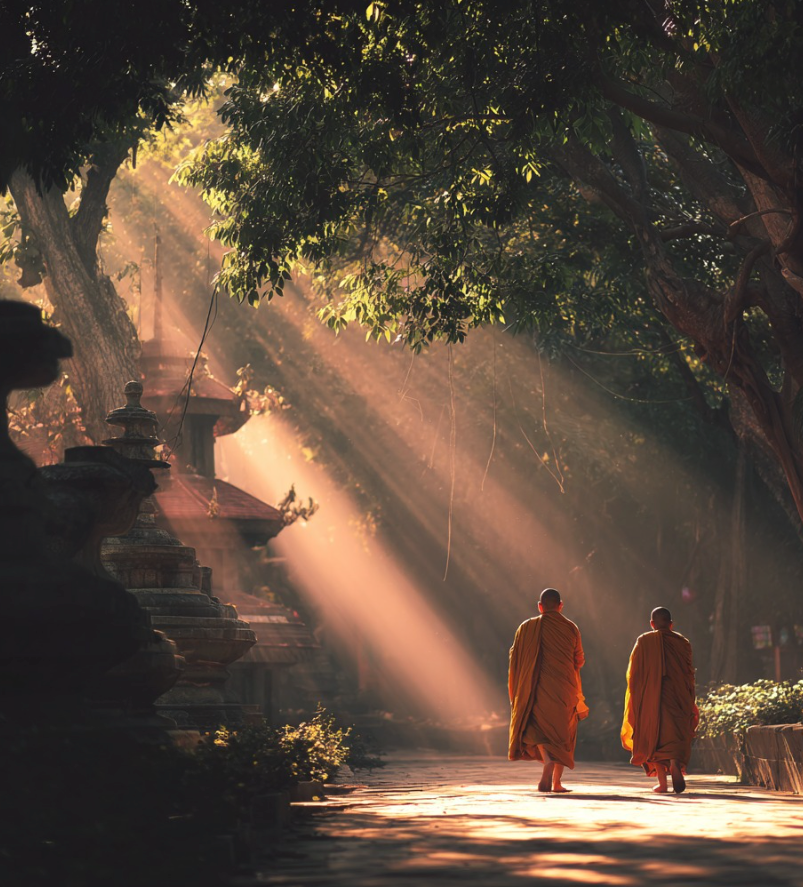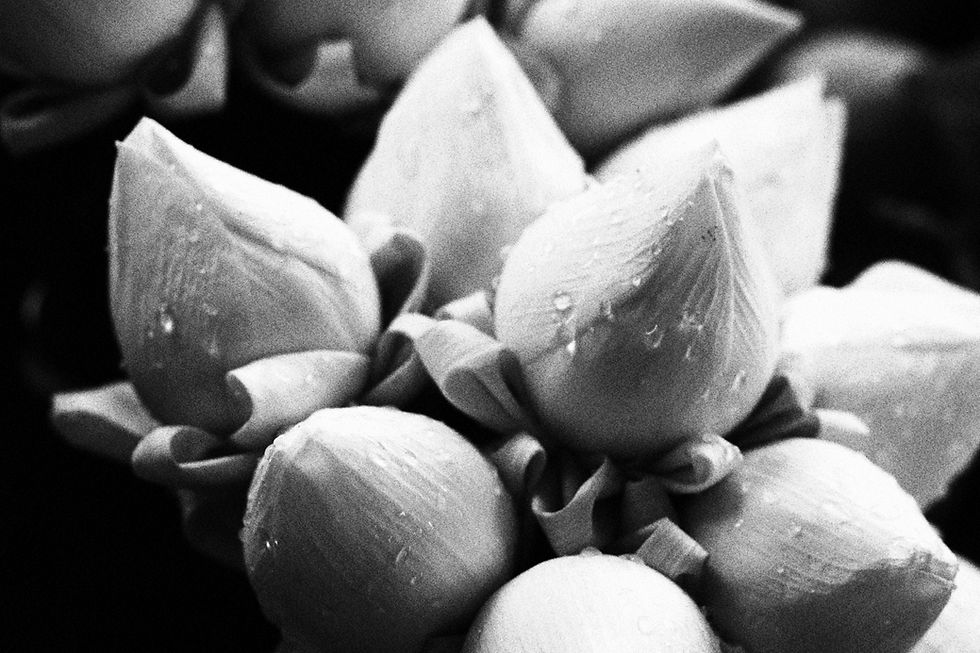AI & Photography for Street Photographers: Creativity vs Authenticity
- Tatiana Mocchetti
- Aug 3
- 9 min read
I recently stumbled upon an Instagram account that left me both intrigued and unsettled. It featured beautiful imagery of Thailand: golden temples glowing in perfect light, monks in dreamy alleys, floating markets swirling in color. But when I looked closer, I realized none of the images were real. Every single one was AI-generated. The page, which also runs a blog about life and work in Thailand, had curated a feed that was visually striking, but built on scenes that never existed. As a photographer living in Thailand, capturing real people and fleeting moments, I couldn’t help but question: What are we really looking at when we scroll? What are we really sharing?
This post explores the tension between AI-powered creativity and the photographer's commitment to authenticity. From the subtle ways AI tools are embedded in our editing software, like Lightroom's distraction removal, to the ethical lines we draw as visual storytellers, I want to reflect on what it means to stay true to reality. Not just for the sake of nostalgia, but for the soul of photography itself.
Let’s explore the shifting ground beneath our feet.
What Is AI-Generated Imagery?
AI-generated images are created not with a lens, but with algorithms. Tools like Midjourney, DALL·E, and Stable Diffusion generate photo-like visuals from text prompts. These tools use massive datasets of existing images to learn patterns, textures, lighting, and compositions, allowing them to fabricate visuals that closely mimic the look and feel of real photographs.
Unlike traditional photography, where a camera captures light from a physical scene, AI-generated images are born entirely in the digital realm. They can show a monk who never existed, walking through a temple that was never built, lit by a sun that never rose. And yet, they can evoke the same emotion, or even greater awe.
This is the paradox: AI images are not fake in their emotional impact—but they are fictional in their source. As photographers, this raises the essential question: If the image was never seen through a lens, can it still be called photography?
The Quiet Invasion of AI in Editing Software
While AI-generated art gets the headlines, AI has already transformed our editing tools. Adobe Lightroom and Photoshop, Luminar Neo, and Capture One now include AI-powered features like sky replacement, object removal, facial retouching, and intelligent masking.
What once required technical precision and manual control is now handled by machine learning models in seconds. A distracting car in the background? Gone. Uneven exposure on a face? Balanced instantly. These tools help us save time and achieve results we previously struggled to produce.
In my own workflow, I appreciate the help. I use AI masking to isolate subjects and content-aware tools to clean up clutter. But I also notice how easy it is to go too far. The temptation to make every frame perfect—flawlessly lit, perfectly composed—is always there. Yet street photography, by nature, thrives on imperfection. So I ask myself: Where is the line between improving an image and falsifying a moment?
Beauty vs. Truth in the Age of AI
AI-generated feeds are undeniably beautiful. Their perfection seduces us: clean lines, golden hour glow, every element thoughtfully composed. They offer the kind of visual consistency that performs well on social media. But as a street photographer, I’ve always chased something different—something real.
Real moments are messy. Faces are asymmetrical. Weather is unpredictable. A bird might blur past the frame, a child might look away. But these moments carry a heartbeat, a trace of life that no algorithm can replicate.
There is beauty in truth. And sometimes, truth is awkward, unbalanced, or raw. As more creators embrace AI to fabricate polished images, the value of genuine documentary work may rise—not fall—because it brings something irreplaceable to the table: presence.


Authenticity and Ethics in Street Photography
Street photography operates on a quiet ethic: you show what you saw. You don’t stage. You don’t swap out skies. You don’t create narratives—you discover them.
In the era of AI, this ethic feels even more vital. If we can invent any image, what becomes of the unfiltered gaze? The unscripted? The flawed but real?
Take, for example, an AI-generated photo of a Thai street vendor. It may feel authentic to someone who’s never been there. But it lacks the layered complexity of life on the ground: the sounds, the smells, the moments of exchange that lead to a photo. A real photograph is shaped not just by light and timing—but by trust.
As street photographers, we aren’t just image-makers. We are witnesses. And our ethics, even if unspoken, help preserve the integrity of what we witness.
How Can I Recognize an AI-Generated Image?
As AI-generated visuals become more advanced, distinguishing them from real photographs is increasingly difficult. Yet, for those of us who live and breathe photography, there are subtle cues that can raise suspicion.
Start by examining the fine details: AI still struggles with certain consistencies, like rendering realistic hands, reflections, or natural folds in fabric. Look at backgrounds—repetitive or distorted elements often betray the algorithm's synthetic process. Facial expressions may seem slightly "off," with symmetrical perfection or lifeless stares.
Context is another clue. Does the image depict a moment that seems too perfectly timed or unrealistically framed? Are there inconsistencies in lighting, shadow direction, or lens distortion? If so, it might be machine-made.
Finally, reverse image searches or tools like AI detection platforms can help verify a photo's authenticity. As photographers, we’re becoming visual detectives. Recognizing AI images isn’t just a technical skill—it’s a way of safeguarding our craft from dilution and confusion.
Understanding these signs helps us navigate the visual world with a more critical eye, and reminds our audience why real photography still matters.

Why Do We Crave Visual Perfection?
Why are we so drawn to AI-generated images? Why does a perfectly lit alleyway or a monk in ideal golden-hour glow captivate us so deeply—even if we know it’s not real?
The answer might lie in the way our brains process beauty. We’re wired to respond to symmetry, balance, clarity, and visual harmony. AI is trained to deliver exactly that. It offers us images that are tailored to our neurological sweet spots—images that feel safe, smooth, and satisfying.
But does that satisfaction translate into meaning? Or memory? That’s where real photography still holds an edge. A photograph taken in the chaos of a real moment carries with it friction, context, and surprise. It may not be perfect, but it stays with us because it was lived.
We may crave perfection, but we remember authenticity. When we scroll past an AI-generated image, our reaction is often: “That’s beautiful.” But when we see a human photograph, our response can be: “I’ve been there.” Or better yet: “I feel that.”
What we long for, in the end, may not be visual polish—but emotional truth. The need to feel connected, to be reminded of real places, real people, and real moments. In this way, the camera remains more than a tool—it’s a witness. And witnessing, in all its imperfection, still has power.
AI vs Human Photography: Who Will Win?
This isn’t a boxing match—but it feels like one. On one side, we have AI: lightning-fast, precise, and tireless. It can generate images 24/7, tuned to aesthetic trends and optimized for engagement. On the other, the human photographer: slower, imperfect, but deeply rooted in experience, observation, and emotion.
Is one the villain and the other the hero? Not necessarily. AI isn’t evil—it’s a tool. But it lacks intuition, memory, and connection. It doesn’t wait for a moment. It doesn’t ask permission. It doesn’t feel joy when a subject smiles back.
If AI is the “good cop” of convenience and creativity, the photographer is the “good cop” of soul and presence. Perhaps the real threat isn’t AI itself, but indifference—the idea that it doesn’t matter where an image comes from, as long as it looks good.
I believe audiences can feel the difference. Maybe not always immediately, but over time. We return to images that move us. And movement—emotional movement—is still best captured by those who are there, living it.
So who wins? In a world of endless visuals, authenticity becomes rare. And in that rarity, photographers hold something powerful. Maybe we don’t win the algorithm. But we win trust. And that, to me, is everything.
Navigating Our Own Ethical Compass
Every photographer needs to define their own ethical boundary. AI tools don’t come with moral guidelines—they just offer possibilities. It’s up to us to decide what’s acceptable, what’s honest, and what stays true to our purpose.
My personal rule is simple: I enhance, but I don’t fabricate. I might remove a distracting piece of trash from the foreground, but I won’t add a monk who wasn’t there or conjure a golden sunset that never happened.
That’s not to say others can’t do things differently. But I believe transparency is key. If you use AI to build or enhance your scene, say so. Let your audience in on the process. Authenticity is not just about technique—it’s about honesty.
AI and the Future of Visual Trust
In response to the rise of AI, some media organizations are testing provenance systems that embed metadata into images—showing when, where, and how a photo was taken and edited. Blockchain-based verification tools are emerging to help validate authenticity.
In the future, photographers might include digital signatures or credentials to differentiate real images from AI-generated ones. This could become a standard in journalism, competitions, and archives.
For now, trust must be built the old-fashioned way: through consistent work, transparency, and a strong ethical voice. In a world where fakes are easy to make, real photographers must work twice as hard to be believed.
Why This Matters for Street Photographers
Street photography is one of the last bastions of unscripted truth. It captures life in motion, without rehearsal. It’s a form of visual journalism, poetry, and anthropology rolled into one.
When AI can generate perfect scenes, the imperfect ones become more precious. A candid smile, a fleeting glance, a slice of life—these are the things AI still can’t replicate authentically.
That’s why I believe the value of street photography isn’t disappearing. It’s becoming more essential. We offer something real, something that doesn’t come from prompts or pixels, but from patience, presence, and respect for the world as it is.

In an era where technology can generate almost anything we can imagine, the photographer's role becomes more vital—not less. Street photography, in particular, offers something AI cannot replicate: an unfiltered look at life as it unfolds. The flaws, the gestures, the unexpected timing—these elements remind us we are alive, and that others are too.
Authenticity may not always trend. It may not always get the likes. But it touches something deeper. And in a world awash with perfect pixels, it’s the imperfect image that tells the truth.
As photographers, our responsibility isn’t to compete with AI. It’s to be present, to see, and to share what’s real. That’s the heart of our work—and it still matters.
FAQs
1. Can AI-generated images be considered photography?No—not by traditional definition. Photography involves capturing light from a real scene. AI-generated images are digital art, even if photorealistic.
2. How do I spot an AI-generated photo?Check for unnatural symmetry, distorted backgrounds, repeated patterns, or overly polished lighting. Use reverse image search or AI detection tools.
3. Is it okay to use AI in Lightroom or Photoshop?Yes—many photographers use AI to save time or remove distractions. The key is maintaining transparency and not altering the reality of the scene.
4. Will AI replace human photographers?Not in street photography or documentary work. What matters is emotional truth, context, and timing—things AI cannot fully replicate.
5. How can we maintain trust in photography today?By being transparent about edits, avoiding fabrication, and supporting initiatives that verify image authenticity.
Let’s Talk
What are your thoughts on AI in photography? Have you experimented with it—or chosen to avoid it? As street photographers, do you think authenticity still matters in a world full of visual illusions?
@live.and.work.in.thailand – Aesthetic feed built with AI-generated images of Thailand, referenced in this article.









Comments